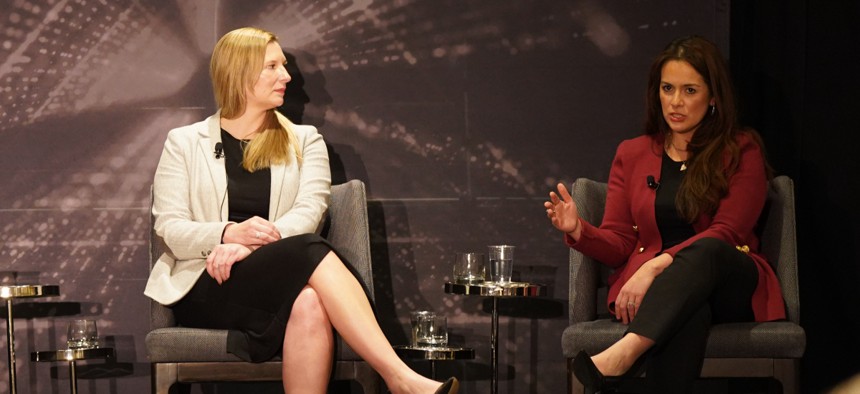
TSA Customer Service Branch Manager Nicole French (L) and USDA Chief Customer Experience Officer Simchah Suveyke-Bogin (R) discuss customer experience at the Nextgov Emerging Technology and Modernization Summit. Stephen Kaise/Staff
3 Customer Experience Tips for Feds from Feds
Two professional customer experience experts offered advice for other practitioners across the federal ranks this month.
Top-notch customer experience does not happen by accident. Rather, it requires a proper mix of strategy, people, culture change and technology over time to improve how people interact and engage with federal agencies.
And though government agencies have struggled for years to match the customer experience offered by leading private sector companies, momentum across the federal ranks continues to build with major executive action and proposed policy and funding enhancements.
Speaking at the Emerging Technology & Modernization Summit March 9, Nicole French, customer service branch manager at the Transportation Security Administration and Simchah Suveyke-Bogin, the Agriculture Department’s chief customer experience officer, outlined a few strategies they’ve employed to positive effect.
Customer experience is everyone’s job
Every year, millions of Americans engage with TSA personnel when they go through security checks at airports across the country. In 2020, French said TSA began employing a course for new TSA hires demystifying customer experience. Thus far, more than 7,000 new TSA hires have undertaken the training module, which is modeled after the Mythbusters television show and outlines eight myths that level set what customer experience is in the context of security. It is highly regarded among new recruits—French said 100% of new hires said they would recommend it—and teaches new employees the importance of professionalism in what can be a stressful experience for travelers.
“A lot of the workforce didn’t think customer experience was part of their job,” French said. “Customer experience isn’t just smiling and telling jokes. We’re asking them to be professional, to use clear communication when someone alarms or requires additional screening and explain it to them. It’s getting back to basics.”
Keep surveys and paperwork as simple as possible
Surveys are one of the federal government’s best tools for gleaning information from the public, but they’ve historically been overly long and outdated by the time results are tabulated. Survey technologies have improved, allowing some agencies to capture real-time—or close to real-time—data from customers. But simplicity in surveys is crucial, Suveyke-Bogin said.
The Department of Agriculture’s Farm Service Agency recently revamped the way it addresses loan applications—which are 26 pages long—seeking ways to make the process simpler for farmers, who are often under stress at these moments.
“They are very, very long, and the team looked at plain language opportunities and accessibility options to shorten the burden for farmers,” Suveyke-Bogin said. “It got approved a few months ago, and now they are rolling that out so farmers and loan officers can use it today.”
In May, TSA plans to conduct a nationwide survey of the agency’s customer experience at 16 airports, addressing a key request in President Joe Biden’s customer experience executive order. Airline passengers going through checkpoints will have the option to participate, answering 15 questions. The questions themselves are simple and focus on trust, professionalism of airport staff and challenges for passengers. French said the survey results, expected by fall, will be shared with the public and could inform future TSA policies and action plans.
“It will be really important for us to highlight how TSA can do better,” French said.
It’s all about people
Customer experience is a business discipline geared around serving the customer, but the people doing the serving matter a lot.
Should the administration’s proposed funding bear out for USDA, the agency may be able to further build out its customer experience wing. If that happens, Suveyke-Bogin explained the kinds of skillsets she’ll be looking for.
“I will see that I think anyone who can contribute to the human-centered design process, anywhere from in-depth knowledge of understanding the needs of people, to designers, researchers, strategists, data scientists and a variety of other backgrounds are beneficial,” Suveyke-Bogin said.
French said she “needs a little bit of everything,” but added that “people who can execute are so important.”







